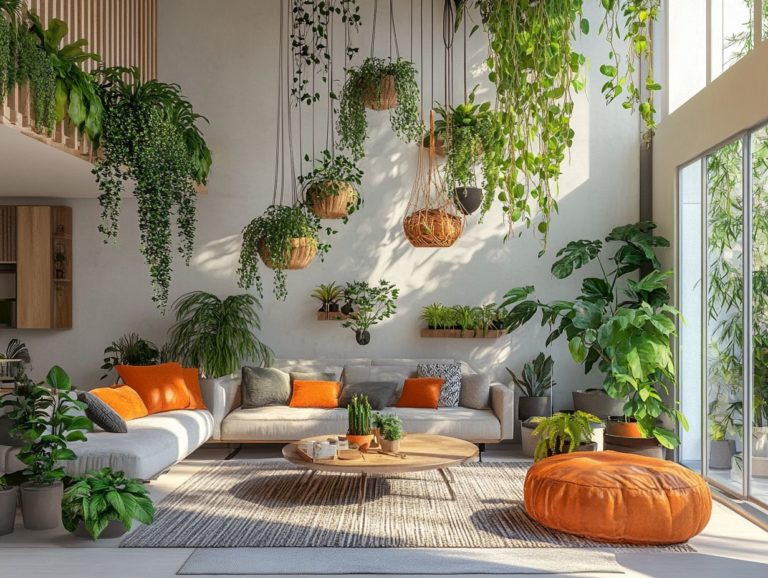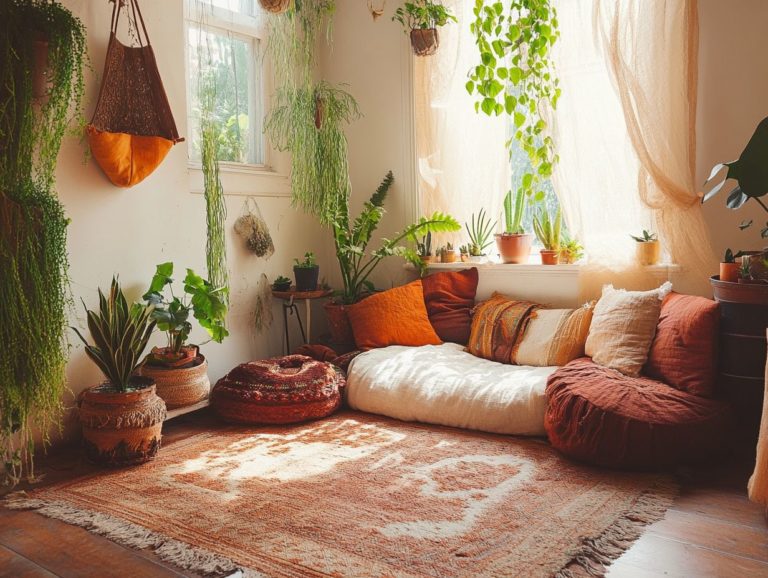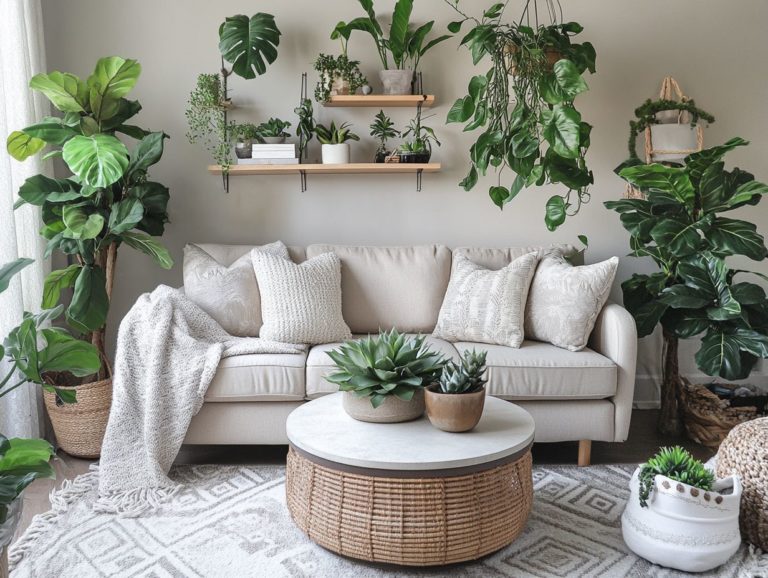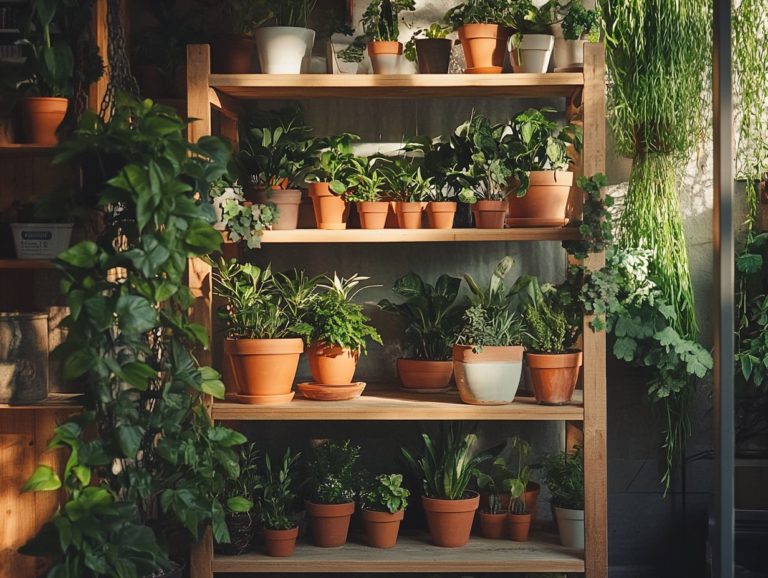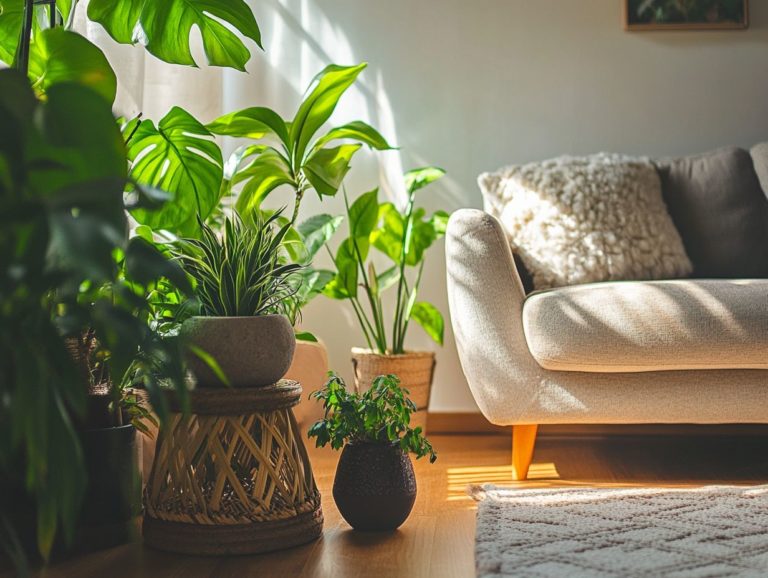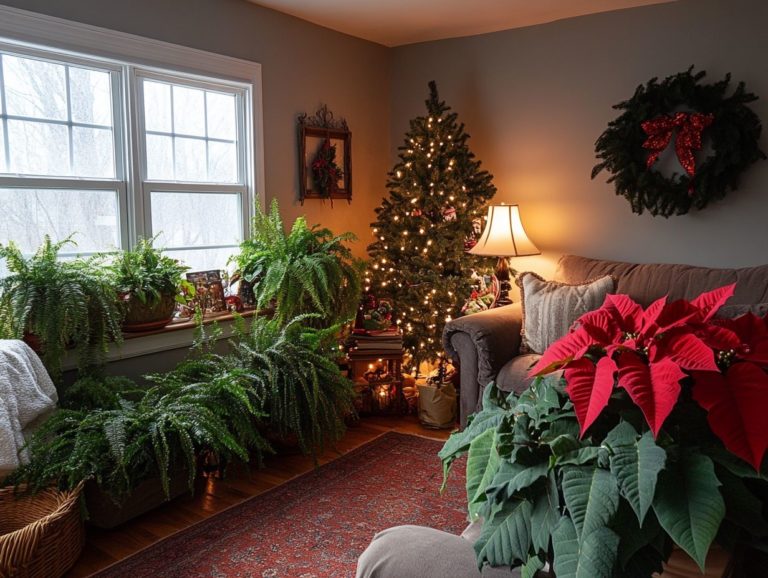Indoor Plants as Stylish Room Dividers
Looking to elevate your living space while infusing a bit of nature? Indoor plants serve as an exquisite solution for crafting stylish room dividers that enhance aesthetics and improve air quality.
This article will delve into the myriad benefits of using indoor plants as dividers. It will guide you in selecting the perfect ones and offer creative design ideas to inspire your vision.
You ll also discover essential care tips to ensure your green dividers flourish, along with a comparison of these botanical options and other room divider alternatives.
Imagine turning your home into a vibrant oasis with the magic of indoor plants! Discover their beauty and the freshness they bring.
Contents
- Key Takeaways:
- Choosing the Right Plants for Dividers
- Design Ideas for Using Indoor Plants as Dividers
- Caring for Indoor Plants as Room Dividers
- Alternative Options for Room Dividers
- Comparing Other Divider Options
- Frequently Asked Questions
- Can indoor plants be used as stylish and natural room dividers?
- What types of indoor plants are best for room dividers?
- Do plants need specific care as room dividers?
- Can indoor plants be used as dividers in any room?
- What are the benefits of using indoor plants as room dividers?
- What creative ideas exist for using indoor plants as dividers?
Key Takeaways:
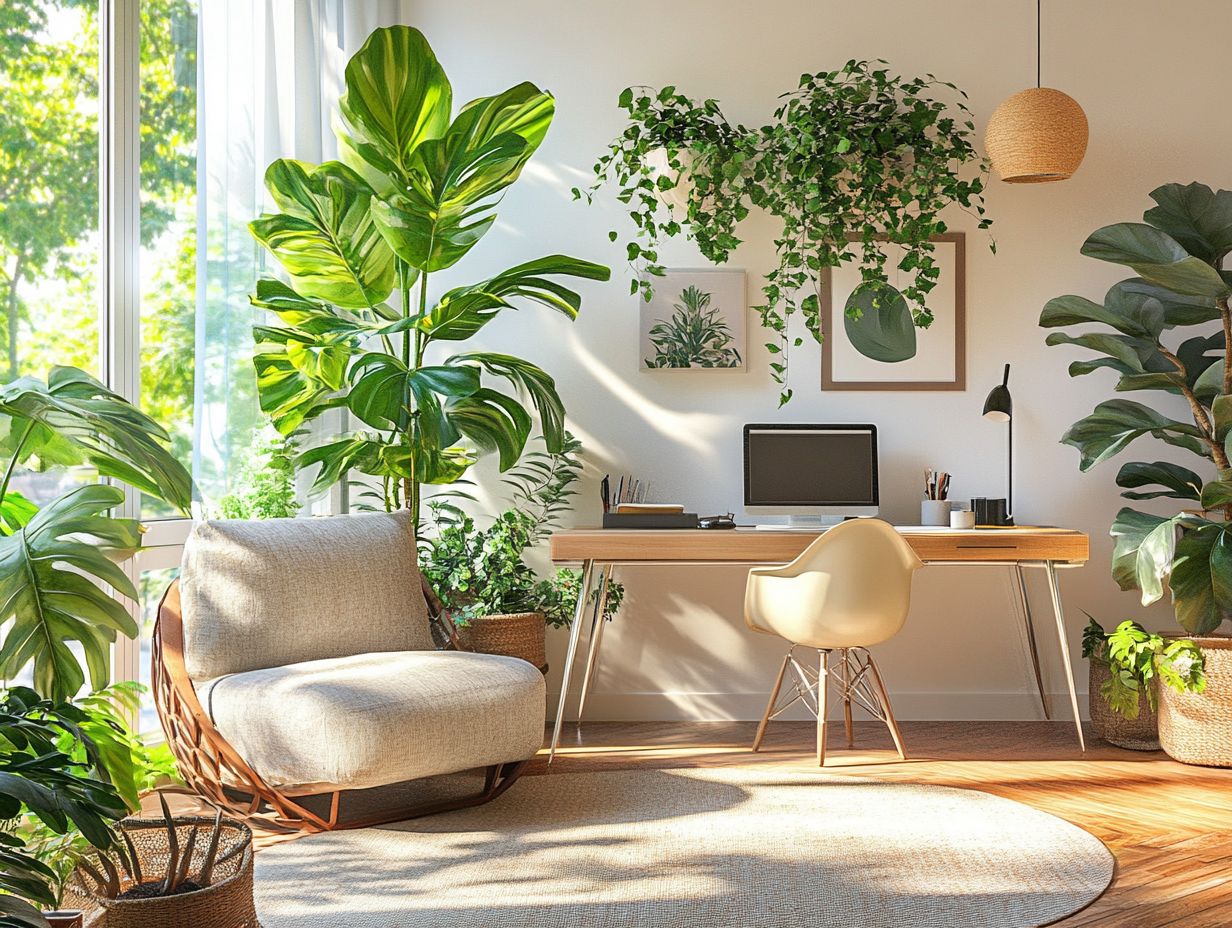
- Indoor plants as room dividers offer both aesthetic and health benefits, such as improving air quality and adding a pop of green to any space.
- When choosing plants for dividers, consider factors like light requirements, size, and maintenance needs to ensure they thrive in their designated space.
- There are endless design possibilities for using indoor plants as dividers from hanging plants to vertical gardens to create a stylish and unique look in any room.
Benefits of Using Indoor Plants as Dividers
Using indoor plants as room dividers brings a wealth of benefits to your living space. They improve air quality and enhance aesthetic appeal, creating calming environments.
Think of them as more than just decorative elements; they can reduce stress and offer a sense of privacy.
Varieties like the Snake Plant and Monstera are particularly effective at minimizing noise, making them perfect for open-concept layouts.
By incorporating greenery as room dividers, you embrace eco-friendly choices that enrich both your space and the planet.
Indoor plants are champions of air purification. They filter out harmful toxins like formaldehyde and benzene, creating a healthier living environment.
Iconic varieties such as the Peace Lily and Spider Plant excel in air cleansing, while their lush foliage absorbs sound, reducing echoes and fostering tranquility. This creates a serene retreat from the chaos of everyday life.
The presence of greenery not only enhances visual appeal but also elevates your overall well-being, promoting relaxation and alleviating anxiety.
Choosing the Right Plants for Dividers
Selecting the right indoor plants for room dividers is essential for achieving that ideal harmony between aesthetics and functionality in your living spaces. Thoughtfully consider factors such as light conditions, available space, and the unique growth habits of different plant species to ensure they thrive.
Plants like the Areca Palm, Monstera Variegata, and Snake Plant are not just visually striking; they also enhance indoor air quality, making them excellent choices for your home.
Factors to Consider
When selecting indoor plants for dividers, you’ll want to consider several key factors to ensure they thrive while enhancing your space. First, think about the lighting conditions some plants, like the Pothos and Rubber Tree, flourish in bright light, whereas others, such as the Parlor Palm, prefer low-light settings.
Understanding the growth habits of your chosen plant species will help you achieve appropriate spacing and placement, creating an indoor garden that is both aesthetically pleasing and functional.
It’s important to evaluate how these plants will grow over time. Certain varieties, like the Fiddle Leaf Fig, can become quite large and may require ample room to spread their leaves.
On the other hand, plants like the Snake Plant are more compact and can adapt seamlessly to tighter spaces without overwhelming your environment.
Additionally, take into account the airflow and humidity levels in the area, as they will further influence your plant selection. For example, tropical plants often thrive in higher humidity, so placing them near windows or in kitchens could be particularly beneficial.
Ultimately, a balanced approach to these factors will help you create an inviting and thriving indoor landscape.
Design Ideas for Using Indoor Plants as Dividers

Incorporating indoor plants as dividers presents a realm of design possibilities. You can craft breathtaking green partitions that enhance the beauty of your living spaces and elevate their functionality.
Imagine using tall, vibrant plants such as the Kentia Palm or Dragon Tree. You can even create vertical gardens that maximize your available space. These options are stylish and adaptable.
Hanging plants in beautiful containers bring height and character. They transform ordinary areas into serene indoor oases brimming with natural elegance.
Creative and Stylish Options
Your options for using indoor plants as stylish dividers are limitless. Consider blending large potted plants with hanging varieties to craft a dynamic indoor garden that also serves as a privacy screen.
This flexible approach not only divides spaces but enhances the soothing ambiance of your home. It delivers both functional and aesthetic benefits.
Tall leafy greens like fiddle leaf figs can stand majestically over low furniture. They offer visual separation while infusing your space with a fresh, inviting atmosphere.
Cascading plants like pothos or string of pearls are perfect for shelves or hanging baskets. They add texture and depth, creating a sense of airy openness.
Incorporating innovative styles like vertical gardens (gardens that grow plants on walls) or terrariums creates a unique display. These not only beautify your surroundings but also purify the air, making your environment healthier.
Pairing these plants with decorative containers can elevate their role. This transforms them into striking focal points that enhance and complement your overall decor.
Caring for Indoor Plants as Room Dividers
Caring for indoor plants that serve as room dividers is crucial for their longevity and the overall health of your indoor space. Proper plant care requires understanding each species’ specific needs, including watering schedules, fertilization techniques, and maintenance practices like repotting and pest management.
Care guidelines differ significantly between species. It’s vital to customize your approach for each plant, whether you re nurturing the hardy Snake Plant or the more delicate Ficus Audrey (a type of houseplant).
Tips for Maintenance and Care
Implementing effective maintenance practices is essential for ensuring the health and beauty of your indoor plants. Regularly checking the watering needs of each plant is crucial.
For instance, you ll find that the Ficus Benjamini often requires more frequent watering than the drought-resistant Bamboo.
Keeping an eye out for pests and knowing when to repot your plants are critical skills for any indoor gardener. To maintain their vitality, establish a consistent watering schedule tailored to each species requirements.
Typically, you’ll want to water the Ficus every 1-2 weeks. Allow the Bamboo to dry out between waterings.
To prevent pest infestations, inspect the foliage regularly. Use natural remedies like neem oil (a natural pest control solution) to keep your plants healthy.
Monitoring root growth is integral. Many indoor plants may need repotting every 12-18 months. This ensures they have ample space and nutrients for continued growth.
By following these targeted maintenance tips, you can cultivate a thriving indoor garden that flourishes and serves as a stunning aesthetic divider in your space, especially with stylish indoor plant arrangements for living rooms.
Alternative Options for Room Dividers
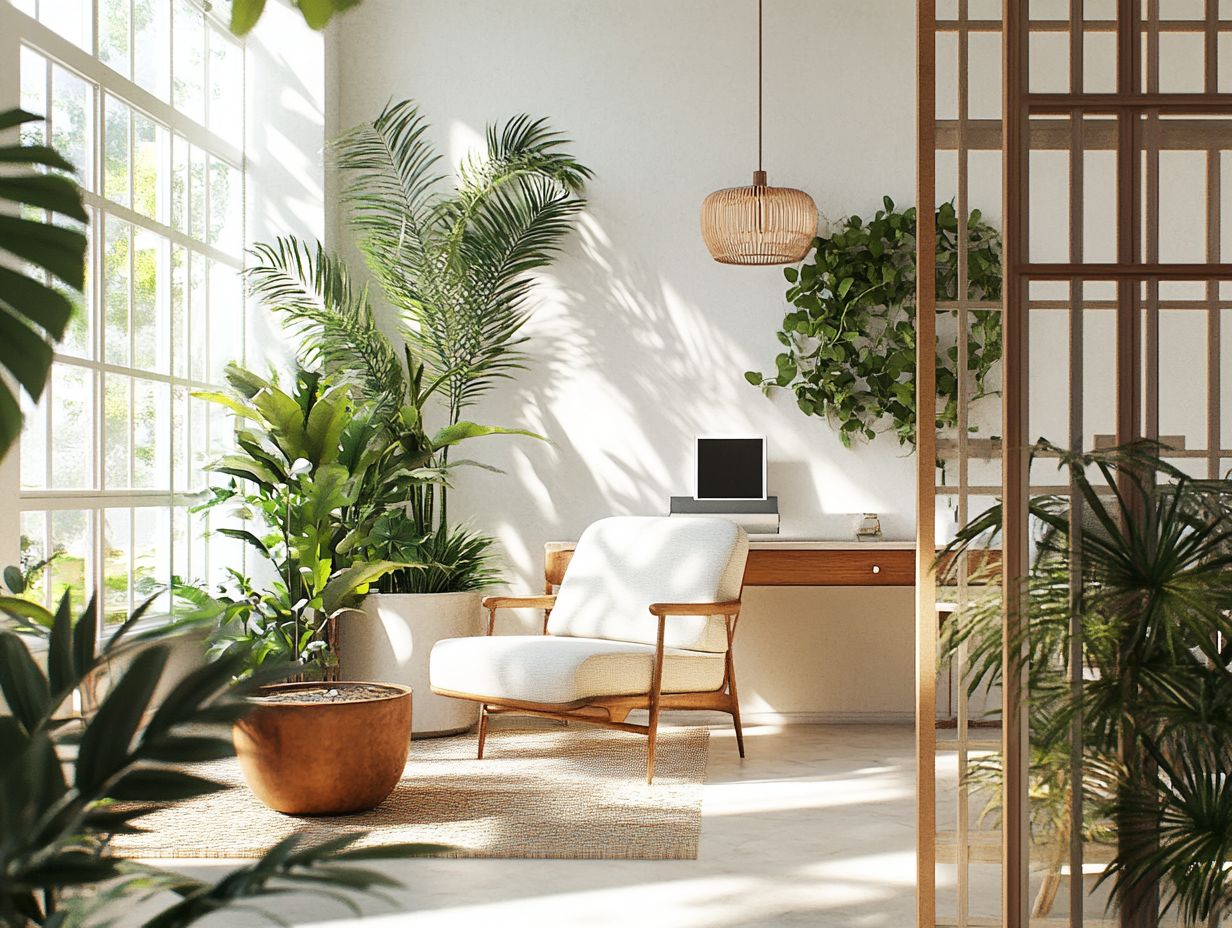
Indoor plants present a visually appealing choice for room dividers. However, there are also other compelling alternatives that enhance environmental sustainability and adaptability within your home.
Explore exciting alternatives like decorative screens and stylish bookshelves to transform your space! Creative furniture arrangements also effectively delineate spaces without sacrificing elegance.
By weighing the advantages of these various options, you can discover the perfect solution to elevate your living areas.
Comparing Other Divider Options
When comparing divider options to indoor plants, consider their unique design ideas and environmental benefits.
Fabric room dividers create a warm atmosphere but lack environmental benefits. In contrast, hard dividers like glass or wooden panels offer strong structure and a sleek look but may not create a nature-like feeling as effectively as living plants.
Choosing between these options means evaluating their visual appeal and how well they enhance air quality. Find the perfect balance between aesthetics and functionality!
Frequently Asked Questions
Can indoor plants be used as stylish and natural room dividers?
Yes! Indoor plants add a stylish touch to any room and serve as functional dividers. They provide a calming effect and enhance the look of your living spaces.
What types of indoor plants are best for room dividers?

Tall, leafy plants such as Areca Palm, Bamboo, fiddle leaf figs, and snake plants create visual barriers and add lush foliage.
Do plants need specific care as room dividers?
Yes, choose plants that thrive in low light and have minimal watering needs. This ensures their health as dividers.
Can indoor plants be used as dividers in any room?
Absolutely! You can use indoor plants as dividers in any room, from the living room to the bedroom, provided there s enough space.
What are the benefits of using indoor plants as room dividers?
Indoor plants not only add style but also purify the air naturally and reduce noise, creating a comfortable environment.
What creative ideas exist for using indoor plants as dividers?
Mix different plant types for an interesting display. Experiment with varying heights and placements to find your ideal arrangement!

